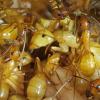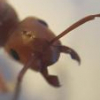- Formiculture.com
- Forums
- Gallery
- Members
- Member Map
- Chat

Media vs sub-major vs major in Camponotus
Started By
giraffedom
, Aug 9 2019 7:45 AM
11 replies to this topic
#1
 Offline
-
Posted August 9 2019 - 7:45 AM
Offline
-
Posted August 9 2019 - 7:45 AM
Could someone please explain how to properly distinguish between media and major workers? Are media and sub-major different words for the same characteristics/caste?
I found a new worker in my Camponotus sansabeanus colony which doesn’t look like the other minors nor the one other major. She’s slightly larger than the largest minor, and notably smaller than the major. Her head is black and broad, unlike minors, but it’s not nearly as large and broad as the major. I’m having trouble deciding if this ant is a media or sub-major, or if the colony just produced a much smaller major this time. I can’t imagine the distinction is solely based on size.
Thanks!
I found a new worker in my Camponotus sansabeanus colony which doesn’t look like the other minors nor the one other major. She’s slightly larger than the largest minor, and notably smaller than the major. Her head is black and broad, unlike minors, but it’s not nearly as large and broad as the major. I’m having trouble deciding if this ant is a media or sub-major, or if the colony just produced a much smaller major this time. I can’t imagine the distinction is solely based on size.
Thanks!
#2
 Offline
-
Posted August 9 2019 - 8:35 AM
Offline
-
Posted August 9 2019 - 8:35 AM
Could someone please explain how to properly distinguish between media and major workers? Are media and sub-major different words for the same characteristics/caste?
I found a new worker in my Camponotus sansabeanus colony which doesn’t look like the other minors nor the one other major. She’s slightly larger than the largest minor, and notably smaller than the major. Her head is black and broad, unlike minors, but it’s not nearly as large and broad as the major. I’m having trouble deciding if this ant is a media or sub-major, or if the colony just produced a much smaller major this time. I can’t imagine the distinction is solely based on size.
Thanks!
Before I say anything, I need to preface this by saying that it's not clear exactly how we define major, supermajor, media, etc. Also, if anyone reading this thinks I am wrong, please feel free to correct me.
As far as supermajors go, there are only 7 species currently alive that are known to have a "supermajor caste." All of them are in the genus Pheidole and all of them are found Arizona, New Mexico, Texas and possibly California plus the areas with a similar climate in North/Central Mexico. (Pheidole tepicana doesn't exactly follow this rule, but don't pay attention to that ![]() )
)
In many of the species with this supermajor caste they are not only larger than the typical majors, but their head is used to block the nest entrance in defense of the colony during Neivamyrmex raids. This brings me to my second point. In order to be a seperate caste, they have to perform a function unique to that caste. In the case of the North American Pheidole with supermajors, it's using their heads to block the nest entrance.
I assume the rule of:
- Different physiology
- Caste-specific behaviors
found in defining supermajors transfers to the other castes, but I can't be certain. It is also likely more complicated than I realize. Obviously nobody is going to call a worker larger than a minor but smaller than a major a supermajor. In that case, it would probably be a media worker. The big problem with this naming system is that you essentially need a myrmecologist to tell you what is what. Since no hobbyist has the methodology required to determine what "castes" are present and doing different tasks.
That being said, it's pretty clear that in the hobby we've agreed on a simple set of rules:
- The smallest workers in the colony are minors
- The workers larger than minors but smaller than the majors are media workers (if present in the species)
- The larger workers are majors (if present in the species)
Now, there is actual physiological differences that define the different castes in a specific species if you ask a myrmecologist, but as hobbyists, we usually don't care or have the tools to identify these differences. Also, who's going to keep track of what each individual worker is in a colony? It just doesn't make sense for a hobbyist.
- giraffedom, Aaron567, rbarreto and 3 others like this
Currently Keeping:
Trachymyrmex septentrionalis
Pheidole pilifera
Forelius sp. (Monogynous, bicolored) "Midwestern Forelius"
Crematogaster cerasi
Pheidole bicarinata
Aphaenogaster rudis
Camponotus chromaiodes
Formica sp. (microgena species)
Nylanderia cf. arenivega
#3
 Offline
-
Posted August 9 2019 - 11:13 AM
Offline
-
Posted August 9 2019 - 11:13 AM
Really interesting topic! I found this:
https://jeb.biologis...0/1/53.full.pdf
It’s a long article and I’ve only gotten through a third of it but, it does shed some light on the physiology of caste selection and the mechanism of caste determination. Hope it helps.
https://jeb.biologis...0/1/53.full.pdf
It’s a long article and I’ve only gotten through a third of it but, it does shed some light on the physiology of caste selection and the mechanism of caste determination. Hope it helps.
- dermy, giraffedom and Gracegarden like this
#4
 Offline
-
Posted August 9 2019 - 11:26 AM
Offline
-
Posted August 9 2019 - 11:26 AM
Camponontus ants do not have worker castes (well, there's a study that suggests nanitics are actually a caste of their own but that's it).
Camponotus are polymorphic ("many shapes") which means that worker caste borders are nonexistent - you have minors (maybe even minims) on one side and majors (or supermajors) on the other side and EVERYTHING IN BETWEEN.
There are medium-sized workers with thin heads - ar they overgrown minors?
There are medium-sized workers with large almost heart-shaped heads - are they small majors?
Are only medium-sized workers with medium-sized roughly round heads medias - or is every medium-sized worker a media?
Also where is the size border between minors and medias? 12mm? Is an ant of 11.8mm a minor and an ant of 12.1mm a major, even if the smaller ant has the bigger head?
There's no real definition of what exactly counts as a majors (or even supermajors) in Camponotus, except for the archetypical big workers with (more or less) heart-shaped heads.
Edited by Serafine, August 9 2019 - 11:28 AM.
- giraffedom, TennesseeAnts, rbarreto and 2 others like this
We should respect all forms of consciousness. The body is just a vessel, a mere hull.
Welcome to Lazy Tube - My Camponotus Journal
#5
 Offline
-
Posted August 9 2019 - 11:35 AM
Offline
-
Posted August 9 2019 - 11:35 AM
Camponontus ants do not have worker castes (well, there's a study that suggests nanitics are actually a caste of their own but that's it).
Camponotus are polymorphic ("many shapes") which means that worker caste borders are nonexistent - you have minors (maybe even minims) on one side and majors (or supermajors) on the other side and EVERYTHING IN BETWEEN.
There are medium-sized workers with thin heads - ar they overgrown minors?
There are medium-sized workers with large almost heart-shaped heads - are they small majors?
Are only medium-sized workers with medium-sized roughly round heads medias - or is every medium-sized worker a media?
Also where is the size border between minors and medias? 12mm? Is an ant of 11.8mm a minor and an ant of 12.1mm a major, even if the smaller ant has the bigger head?
There's no real definition of what exactly counts as a majors (or even supermajors) in Camponotus, except for the archetypical big workers with (more or less) heart-shaped heads.
Very interesting! As I see this the more I watch my Camponotus Colonies. I mean I tend to say the smallest sizewise range are minors, the larger range are Majors and call the largest Super Majors but there really are "everything in between". I never even heard the term "Media" used before so I have no idea on that.
Billy
Currently keeping:
Camponotus chromaiodes
Camponotus castaneus
Formica subsericea
#6
 Offline
-
Posted August 9 2019 - 12:11 PM
Offline
-
Posted August 9 2019 - 12:11 PM
Hmmm Serafine, I’m a relative newbie but according to A Field Guide to the Ants of New England, the workers of the 8 species of Camponotus that reside here can be defined by caste. Further, the article I’ve linked suggests the size differentiation isn’t based on a hard gradation but rather, a continuum with both anatomic and phenotypic variations. Doesn’t polymorphism denote caste? I think we’re using different words to say the same thing.Camponontus ants do not have worker castes (well, there's a study that suggests nanitics are actually a caste of their own but that's it).
Camponotus are polymorphic ("many shapes") which means that worker caste borders are nonexistent - you have minors (maybe even minims) on one side and majors (or supermajors) on the other side and EVERYTHING IN BETWEEN.
There are medium-sized workers with thin heads - ar they overgrown minors?
There are medium-sized workers with large almost heart-shaped heads - are they small majors?
Are only medium-sized workers with medium-sized roughly round heads medias - or is every medium-sized worker a media?
Also where is the size border between minors and medias? 12mm? Is an ant of 11.8mm a minor and an ant of 12.1mm a major, even if the smaller ant has the bigger head?
There's no real definition of what exactly counts as a majors (or even supermajors) in Camponotus, except for the archetypical big workers with (more or less) heart-shaped heads.
Edited by ConcordAntman, August 9 2019 - 12:20 PM.
#7
 Offline
-
Posted August 9 2019 - 12:30 PM
Offline
-
Posted August 9 2019 - 12:30 PM
Camponontus ants do not have worker castes (well, there's a study that suggests nanitics are actually a caste of their own but that's it).
Camponotus are polymorphic ("many shapes") which means that worker caste borders are nonexistent - you have minors (maybe even minims) on one side and majors (or supermajors) on the other side and EVERYTHING IN BETWEEN.
There are medium-sized workers with thin heads - ar they overgrown minors?
There are medium-sized workers with large almost heart-shaped heads - are they small majors?
Are only medium-sized workers with medium-sized roughly round heads medias - or is every medium-sized worker a media?
Also where is the size border between minors and medias? 12mm? Is an ant of 11.8mm a minor and an ant of 12.1mm a major, even if the smaller ant has the bigger head?
There's no real definition of what exactly counts as a majors (or even supermajors) in Camponotus, except for the archetypical big workers with (more or less) heart-shaped heads.
Do you have any sources to cite? I'm curious to learn more about this.
- Acutus likes this
Currently Keeping:
Trachymyrmex septentrionalis
Pheidole pilifera
Forelius sp. (Monogynous, bicolored) "Midwestern Forelius"
Crematogaster cerasi
Pheidole bicarinata
Aphaenogaster rudis
Camponotus chromaiodes
Formica sp. (microgena species)
Nylanderia cf. arenivega
#8
 Offline
-
Posted August 9 2019 - 1:20 PM
Offline
-
Posted August 9 2019 - 1:20 PM
The term polymorphic literally says "many forms" compared to dimorphic or trimorphic (or even octomorphic if they ever find an an species with 8 castes).Do you have any sources to cite? I'm curious to learn more about this.
I can also send you pics of my Camponotus barbaricus (or you can look them up in my journal) - my midde-sized ants have the entire variety from narrow heads to huge heart-shaped heads.
Usually the bigger the worker the higher the chance of a big head but I've had some workers of around 14mm in length with super thin minor heads.
- TennesseeAnts likes this
We should respect all forms of consciousness. The body is just a vessel, a mere hull.
Welcome to Lazy Tube - My Camponotus Journal
#10
 Offline
-
Posted August 9 2019 - 3:11 PM
Offline
-
Posted August 9 2019 - 3:11 PM
Yeah I'm very intrigued by all of this now!
Billy
Currently keeping:
Camponotus chromaiodes
Camponotus castaneus
Formica subsericea
#11
 Offline
-
Posted August 10 2019 - 2:12 AM
Offline
-
Posted August 10 2019 - 2:12 AM
Could it be defined by head shape/size instead of body size?
There is no real definition as caste borders don't exist and even head size varies across the entire spectrum. It's a bit complicated.
We should respect all forms of consciousness. The body is just a vessel, a mere hull.
Welcome to Lazy Tube - My Camponotus Journal
#12
 Offline
-
Posted August 10 2019 - 5:31 AM
Offline
-
Posted August 10 2019 - 5:31 AM
Once again, I think we’re all saying the same thing though, I agree most with Mdrogun
http://www.formicult...notus/?p=122717
From my reading, caste is determined by an ant’s genetic makeup modified by hormonal (endogenous and exogenous) and environmental stimuli. I quote from the article I linked (Journal of Experimental Biology (2017) 220, 53-62).
The abstract:
Female ants display a wide variety of morphological castes, including workers, soldiers, ergatoid (worker-like) queens and queens. Alternative caste development within a species arises from a variable array of genetic and environmental factors. Castes themselves are also variable across species and have been repeatedly gained and lost throughout the evolutionary history of ants. Here, we propose a simple theory of caste development and evolution. We propose that female morphology varies as a function of size, such that larger individuals possess more queen-like traits. Thus, the diverse mechanisms that influence caste development are simply mechanisms that affect size in ants. Each caste-associated trait has a unique relationship with size, producing a phenotypic space that permits some combinations of worker- and queen-like traits, but not others. We propose that castes are gained and lost by modifying the regions of this phenotypic space that are realized within a species. These modifications can result from changing the size– frequency distribution of individuals within a species, or by changing the association of tissue growth and size. We hope this synthesis will help unify the literature on caste in ants, and facilitate the discovery of molecular mechanisms underlying caste development and evolution.
From pp 54-5:
The definitions of ‘caste determination’ and ‘caste differentiation’ are not consistent in the ant literature, which has contributed to confusion in the understanding of caste development. Here, we borrow from the sex development literature to provide definitions that are explicitly tied to biological processes. The available data reveal that caste-associated traits vary as a function of size: larvae that pupate at greater mass become adults with more queen-like traits. In light of this evidence, caste determination can be defined as the complex integration of many mechanisms that influence the size of larvae at pupation. The size–frequency distribution, therefore, is the outcome of caste determination across all of the larvae in a colony (Wilson, 1953; Wheeler, 1991). Caste differentiation, in contrast, is the developmental mechanism producing the association of size and phenotype. It is specifically the process by which tissues in developing larvae and pupae differentiate in a worker- or queen-like manner in association with size (Miyazaki et al., 2010).
From the section on caste determination p 55:
Many factors, including genotype, maternal effects, wounding, temperature and rearing environment can influence nutrition and/or the endocrine system, affecting size and caste development.
The above describes the basis for the physical variations we see and the anatomic variations we lack the tools to dissect. Overall, it’s just what the title of the article says: Caste development and evolution in ants: it’s all about size! Not the size of the gaster, the mesosoma, or the head as separate parts, but the size of the ant as a whole with the relative size of its parts being an additional caste identification characteristic.
http://www.formicult...notus/?p=122717
From my reading, caste is determined by an ant’s genetic makeup modified by hormonal (endogenous and exogenous) and environmental stimuli. I quote from the article I linked (Journal of Experimental Biology (2017) 220, 53-62).
The abstract:
Female ants display a wide variety of morphological castes, including workers, soldiers, ergatoid (worker-like) queens and queens. Alternative caste development within a species arises from a variable array of genetic and environmental factors. Castes themselves are also variable across species and have been repeatedly gained and lost throughout the evolutionary history of ants. Here, we propose a simple theory of caste development and evolution. We propose that female morphology varies as a function of size, such that larger individuals possess more queen-like traits. Thus, the diverse mechanisms that influence caste development are simply mechanisms that affect size in ants. Each caste-associated trait has a unique relationship with size, producing a phenotypic space that permits some combinations of worker- and queen-like traits, but not others. We propose that castes are gained and lost by modifying the regions of this phenotypic space that are realized within a species. These modifications can result from changing the size– frequency distribution of individuals within a species, or by changing the association of tissue growth and size. We hope this synthesis will help unify the literature on caste in ants, and facilitate the discovery of molecular mechanisms underlying caste development and evolution.
From pp 54-5:
The definitions of ‘caste determination’ and ‘caste differentiation’ are not consistent in the ant literature, which has contributed to confusion in the understanding of caste development. Here, we borrow from the sex development literature to provide definitions that are explicitly tied to biological processes. The available data reveal that caste-associated traits vary as a function of size: larvae that pupate at greater mass become adults with more queen-like traits. In light of this evidence, caste determination can be defined as the complex integration of many mechanisms that influence the size of larvae at pupation. The size–frequency distribution, therefore, is the outcome of caste determination across all of the larvae in a colony (Wilson, 1953; Wheeler, 1991). Caste differentiation, in contrast, is the developmental mechanism producing the association of size and phenotype. It is specifically the process by which tissues in developing larvae and pupae differentiate in a worker- or queen-like manner in association with size (Miyazaki et al., 2010).
From the section on caste determination p 55:
Many factors, including genotype, maternal effects, wounding, temperature and rearing environment can influence nutrition and/or the endocrine system, affecting size and caste development.
The above describes the basis for the physical variations we see and the anatomic variations we lack the tools to dissect. Overall, it’s just what the title of the article says: Caste development and evolution in ants: it’s all about size! Not the size of the gaster, the mesosoma, or the head as separate parts, but the size of the ant as a whole with the relative size of its parts being an additional caste identification characteristic.
Edited by ConcordAntman, August 10 2019 - 5:33 AM.
- PacificNorthWestern likes this
0 user(s) are reading this topic
0 members, 0 guests, 0 anonymous users



















